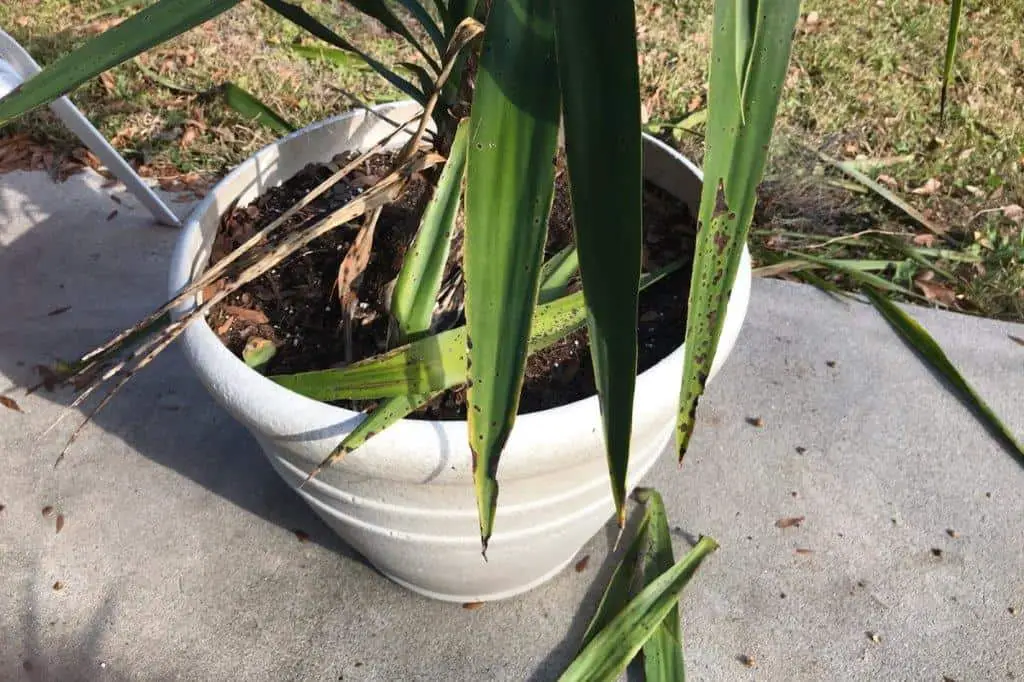A yucca plant is hardy and does not require excessive maintenance. It produces small white flowers. But when your Yucca looks bad, it causes concern. So how do you know if your Yucca plant is dying?
Your Yucca is showing signs of dying when:
- roots have turned a brown, yellow, or black color.
- leaves turn brown around the edge.
- leaves drop off.
- slow growth or no growth.
- wilting leaves yellowing near the stalk of the plant.
The Yucca plant does not need much care, and overwatering is the culprit that usually instigates death. We’ll outline what you need to know to identify a dying Yucca.
What Does an Unhealthy Yucca Plant Look Like?
The roots should ideally have a clean, fresh smell, and when you cut them open, they should contain a snowy white center. If you want to see if the root is still healthy, break off the Yucca leaves near the trunk. Several indications to look for in the flesh that indicates a dying Yucca are:
- black spots
- lines
- discoloration
These are all signs of disease and lack of Yucca health.
Signs that Overwatering is Killing Your Yucca
When you overwater your Yucca, the leaves droop even more, and the excess water rots the roots. Overwatered roots cannot breathe. The roots cannot get oxygen and nutrients from the soil when too much water is blocking them.
The Yucca plant naturally has water inside it, so adding more water to the Yucca can be a death sentence. Fortunately, if you catch it in time, the edema is reversible. Yuccas can survive on as little as 8 inches of rainfall per year when the plant is outdoors.
There are several indicators that you have overwatered your Yucca:
- rotten or decaying roots have brown spots and a foul smell.
- if the Yucca plant is droopy or turning yellow, brown, or black, it is unhealthy.
- fungal diseases destroy the roots, which become slimy and brown
- yellow leaves and new growth on the plant falling off.
When the leaves start shedding, the end may be near. Shedding means that the yucca plant is dying, and it can’t be nurtured back.
Yucca trees are susceptible to damage from from some fungal pathogens that cause leaf spots. Insects are another source. If the condition is focused on a few leaves, you can trim off the affected foliage. Try not to trim the foliage when it is raining. This could encourage microbes, and that would add to the problem.
What are The Signs Of Disease in a Yucca?
Remove anything you’ve cut off fromm the yucca or surrounding plants. This will keep the fungus from spreading. If there are insects, caught the leaves they’re eating off. This will help control the infestation.
If the Yucca is too moist, fungal disease can attack. The following are some signs of diseases that can harm your Yucca.
What are The Brown Spots?
Brown spots on the leaves are a prevalent problem and are caused by fluoride poisoning. Fluoride is in regular tap water in most areas and was put in the water to deter tooth decay in children and young adults. The spots on the leaves are usually 2 to 3 centimeters in diameter and are surrounded by purple. These spots first appear as little clear areas in older leaves.
The spots turn yellow and then brown once they mature. They are found dispersed all over the surface of the leaves that are at the Yucca’s base. You can control this by removing the infected leaves. Use distilled water to eliminate the fluoride.
Another cause of the brown spotting is a fungus caused by not having the plant in a well-drained area and overhead watering. Water, the plant from the bottom, only, and use a fungicide containing mancozeb or chlorothalonil.
Older Yucca Leaves Have Gray Spots
This type of spotting is another common problem. It occurs more often in older leaves and presents as lesions, which are gray and brown. This fungus comes from overhead watering or spraying and having your plant in an area that does not drain well. You can manage this by spraying pesticides on the infected leaves.
Stem Rot Creates Bad Odor
If you do not prevent decay from the start, it can trigger the destruction of the entire plant. Bacteria causes rotting. The stem will have a watery discharge and an offensive odor. You can prevent this by using only sterilized pots and suitable potting soil when planting the cuttings.
Sclerotia Found Near Soil
Sclerotia will present as a white cottony growth on the plant. It is typically found on the stems near the surface of the soil. Besides the white growth, the most significant sign of the disease is root rot. The plant’s roots will be:
- brown
- slimy
- foul odor
Overwatering triggers sclerotia. Although it can be treated with a fungicide, it can’t be completely eliminated.
Can I Save a Dying Yucca?
If your Yucca is dying, you may be able to save it. Stop overwatering the plant. Don’t allow the Yucca to sit in a puddle of water because this will further damage the plant.
Keep the temperature as constant as possible and allow the air to circulate. You need to remove all the rot by cutting the trunk. Cut the trunk directly above the area where it is rotting. The roots should be light in color. Let some time go by before watering again.
Conclusion
If your Yucca plant is displaying discoloration on its leaves, it is sick and possibly dying. Depending on the color of the lesions, you should be able to treat the plant and maybe save its life. The number one thing you can do to save your Yucca is to stop overwatering it.


